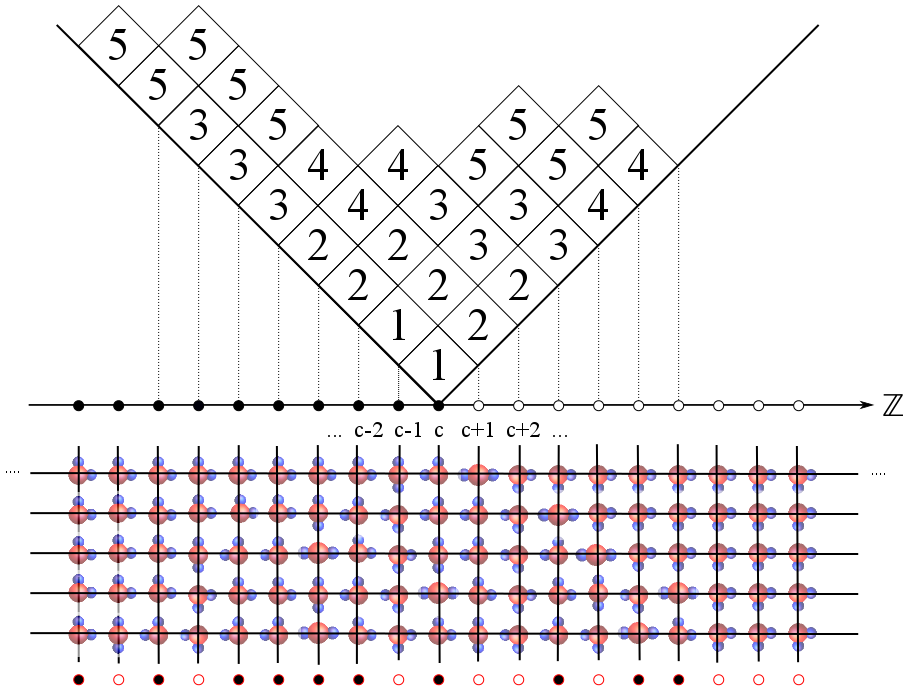Exactly solvable lattice models

Figure: The ice model describes the alignment of water molecules on a square lattice: there are six possible configurations for an H2O modlecule at each lattice vertex, hence, this is also called the six-vertex model. Under suitable boundary conditions the ice configurations can be matched to ribbon tableaux in combinatorics where they describe irreducible characters of the Iwahori-Hecke algebra of type A.
Background
One of the most celebrated models in statistical mechanics is the (two-dimensional square-lattice) Ising model which describes ferromagnetism, and which was solved analytically by Lars Onsager in 1944. His solution was based on an infinite-dimensional algebra, now called the Onsager algebra, which today is understood to be related to the loop algebra of sl(2), a particular example of a Kac-Moody algebra although the wok of Kac and Moody came much later.
Baxter’s work in the 1980s introduced the method of commuting transfer matrices based on solutions of the quantum Yang-Baxter equation and his subsequent solution of the eight-vertex model revolutionised much of the area showing that exact solutions are possible in a much larger class of statistical lattice models. Similar to the case of the Ising model infinite-dimensional algebras play a pivotal role: solutions to the quantum Yang-Baxter equation can be classified in terms of so-called “quantum groups” or q-deformed enveloping algebras of Kac-Moody algebras introduced by Drinfel’d and Jimbo in the mid 1980’s. This links this area of statistical lattice models firmly to the area of representation theory in mathematics and there is a mutual cross-fertilisation of techniques covering besides quantum groups a wealth of different types of other algebras, such as Hecke or Temperley-Lieb algebras.
Modern mathematical aspects of these lattice models pursued here in Glasgow are a description of the underlying combinatorics of lattice models, many of them have partition functions which are special either because of their algebraic or geometric applications, for example in describing quantum cohomology and Gromov-Witten invariants, or their links with enumerative combinatorics.
Physically these lattice models have received much attention because many of them exhibit phase transitions near so-called critical points where the parameters are tuned to certain special values. At the critical point the system can be described effectively in terms of two-dimensional conformal field theories. The long-term goal is to compute exact (analytic) expressions for correlation functions. For example, in the Ising model the probability to find two spins aligned is important to understand the correlations in the system and one celebrated result is that the corresponding correlation function is a solution of the Painleve VI equation.
Researchers
Publications
- Cylindric Hecke Characters and Gromov–Witten Invariants via the Asymmetric Six-Vertex Model, Communications in Mathematical Physics, 381, (2021).
- Cylindric Versions of Specialised Macdonald Functions and a Deformed Verlinde Algebra, Communications in Mathematical Physics, 318, (2013).
- A Q-operator identity for the correlation functions of the infinite XXZ spin-chain, Journal of Physics A: Mathematical and General, 38, (2005).
- Auxiliary matrices for the six-vertex model at qN = 1 and a geometric interpretation of its symmetries, Journal of Physics A: Mathematical and General, 36, (2003).
Grants
- Integrable systems and symmetric functions, LMS workshop (2023).
- Integrable models and deformations of vertex algebras via symmetric functions (EPSRC)
- Quantum integrable systems and infinite dimensional algebras (University Research Fellowship of the Royal Society London)
- Discrete integrable systems and the crystal limit of quantum integrable models (British Council)
- New developments in correlation functions of integrable lattice models (EPSRC)

